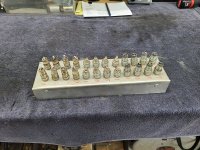@J Alper I published that one and couple others on here before the "crash" Glad to see it coming back. Tuning is so important, and yeah nearly everyone with a built LS is running what I would consider a race engine and most are running "box" tunes with some touch ups.
I am a huge Steve Morris fan, he is the real deal.
What he does not say in that video is "how to Prep to read plug"
It does absolutely No good in most cases to pull a plug out of a running engine that you took a run with and idled back to camp and pulled the plug or been running all weekend on ands pull a plug and try to "read it".
I chuckle when people tell me "I read the plugs and they said" when I know they did it wrong and they are Mis-diagnosing the issue or thinking they have one.
Its not rocket science, but there are many factors that affect the plugs, and as
@Kevin said you can learn way more by a damaged plug than by the color
Especially if you run Race gas, Octane booster, or God Forbid Meth Injection... Race gas additives discolor plugs and make strange readings, the MMT in Octane Booster makes the Plugs look like Orange Man Bad" Meth injection (when it does not fail) "cleans the pugs off really well' The design of the heads 12 degree or 15 degree affect flame travel and you can have one side of the plug look good and other side look bad and since no one bothers to "clock the electrode" on plugs anymore you can have two "bad actor" cylinders and only see a rounded electrode on one because the electrode was turned differently,
I am guilty of tuning (on Holley) by individual cylinder by reading the plugs - Manifolds do not distribute fuel evenly and and unless the headers are equal length you will have lean and rich cylinders and hot and cold cylinders, and unless you drop the engine on the engine dyno with individual EGTS you will never know. This is why I put every engine (for me) on the engine dyno before it goes in the car (and I hate leaks and they are easier to fix when the engine is out of the car if you have one).
----
The only way to read the plugs to get any useful information from them is to heat the engine. pull the plugs, put in fresh plugs - Make a Dyno run or take a hard pass right then (be lined up to take the pass as soon as you start the car) and Immediately shut the engine down - don't let it idle ( tough to do on Turbo engines - on turbos - just don't heat the engine first - cold run and then you can shut down quick)
Good Tuners that want the Max Safe power will change the plugs 3x or more in a Dyno session, some will just EGT all cylinders or get the IR heat gun out quickly
Its really the only way to know what ios going on inside the cylinder - even a borescope will not tell you as much
I have never done a tune where the plugs have not come out at least once and gotten changed - I don't usually cut the open but I use aLongacre Plug reader - basically a light with a magnifying glass like this - its hard to read one correctly with out it, especially on a Blown or Turbo engine where lil pieces of piston melted off end up like balls at the bottom of the Porcelain (too much timing, not enough octane). Readers are cheap.
https://www.longacreracing.com/products.aspx?itemid=1740&prodid=7658&pagetitle=Spark-Plug-Viewer
these are Handy guides as well
https://www.championautoparts.com/Parts-Matter/automotive-repair-and-maintenance/how-to-read-spark-plugs.html
The Champion guide is useless if you let the engine idle for more than say 20 seconds ....
https://www.dragstuff.com/techarticles/how-to-read-plugs.html
This series of articles is great - the pics tell the story


